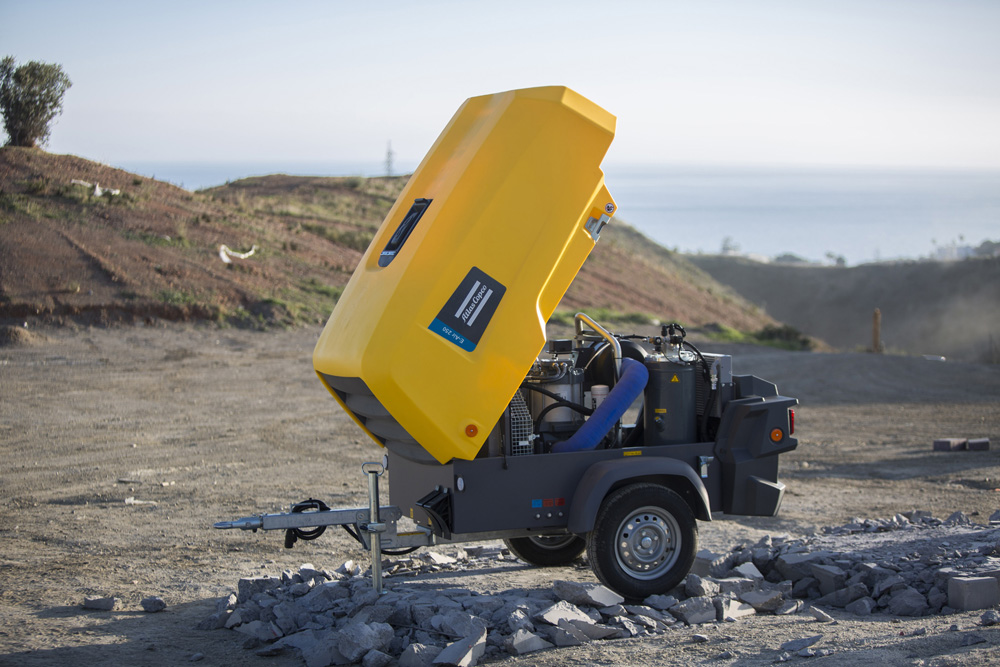
In some quarrying and mining locations, site conditions dictate the use of either diesel or electric compressors because of their specific constraints. Where there is no electric power available, diesel becomes the only solution. Where the noise or emissions requirements are very high (e.g. in confined spaces), then electric compressors are mandatory.
All other cases require an assessment of the trade-offs related to the application. Factors to consider include trends in legislation, the total cost of ownership (TCO), safety, noise and emissions, the robustness of outdoor conditions and portability. Over the last few years, electric compressors have developed to such an extent that their benefits tend to exceed those of diesel compressors in most cases.
This article explores the trade-offs between diesel and electric compressors and highlights the areas where electric compressors could help quarry operators unlock new benefits.

Any new diesel compressors must meet the current emissions standards. In Europe, this means Stage V, which came/will come into effect in 2019 and 2021 depending on the engine size. Stage V aims to reduce CO2 and NOx and requires exhaust after-treatment to comply.
But regulators raise emissions standards continuously. Even though Stage V has only just come into force, Stage VI is already under discussion. New regulations are likely to push the costs of diesel compressors upwards as manufacturers develop new technologies to keep up with the changing standards.
Electric compressors have zero emissions. They consume energy and therefore, do contribute to the carbon footprint of a site. But their contribution is lower than that of a local diesel engine on site.
The total cost of ownership is the sum of all expenses associated with a piece of equipment from purchase until resale as a used item. It includes capital cost, energy utilisation and maintenance. Each of these is discussed separately below in a comparison between diesel and electric technology.
At this stage, the market for used diesel compressors is more established than for electric models. However, as the electric market grows, the resale values should reflect a similar trend to diesel models.
Diesel compressor costs are increasing due to improvements in technology required by rising emission standards. A diesel compressor costs about 25% more today than it did five years ago. The efficiency improvements can offset some of this cost compared to older models.
Electric compressors have fewer variables contributing to their manufacturing cost. Developments in technology are performance-driven because they have zero emissions. For example, the Atlas Copco E-Air VSD range has a unique in-house-designed permanent magnet motor for optimal performance and minimal dust ingress.
However, purchase price is not the primary consideration when it comes to choosing which technology to adopt. The purchase price of a new portable compressor accounts for less than one-third of the total cost of ownership. Other costs like energy consumption and maintenance play a significant role.
The primary operating cost of portable compressors is due to its energy consumption. Trade-offs between diesel and electric models depend on the difference between fuel costs and electricity costs, which is illustrated by the following calculation:
A diesel-driven compressor rated at 250 CFM (7 m³/min) consumes 13.2 litres of fuel per hour. Assuming an average fuel cost of €1 per litre, the diesel compressor has an operating cost of €13.2 per hour. On the other hand, an equivalent electric compressor connected to the grid consumes 38kWh of electricity. Taking an average European electricity cost of €0.25 / kWh, the electric compressor has an operating cost of €9.50 per hour.
The electric compressor solution seems cheaper than diesel, but costs vary from region to region. These calculations must be updated for local contexts.
Compressor efficiency has a direct impact on energy consumption and therefore operating cost. A more efficient compressor consumes less energy to produce the same amount of air.
Diesel air compressors use general-purpose diesel engines. They lack the efficiency of a driver that matches the compressor characteristics for optimum performance. However, the bigger the diesel engine, the more efficiently it runs. Large diesel air compressors, therefore, have very high energy efficiencies.
Electrically driven compressors have motors specially designed for compressor service. The permanent magnet motor used in Atlas Copco’s e-Air range of compressors is the most efficient type of motor in the market. They prevent dust ingress and have an excellent performance across a wide operating range.
It is important to note that Tier 4 diesel engines represent the latest technology and the highest levels of efficiency. Older Tier 2 and Tier 3 models are not as efficient as newer Tier 4 engines. Therefore, electric compressors offer even more benefits over Tier 2 or 3 models compared to Tier 4 models.
Electrically driven compressors offer substantial benefits over diesel compressors in terms of maintenance. Electric motors don’t have removable engine parts, so the only maintenance task is to regrease bearings. Costs of spares, labour hours for servicing and ease of maintenance tasks are all in favour of electric motors over diesel engines.
The simplicity of the electric solution over diesel also affects the service interval requirements. Diesel engines need servicing every 500 hours, although newer models could extend this interval up to 1,000 hours or two years. Electric motors can run for 1,500 or even up to 2,000 hours between services. Maintenance costs for a diesel compressor average at €1 per hour, although these costs are reducing with newer machines.
Electric air compressors have a 50% lower operating cost than diesel compressors based on energy use and maintenance savings.
One question that gets regularly asked is whether electric air compressors can withstand the harsh outdoor conditions found in quarry or mining applications. Diesel compressors have a long track record of service in these environments. They have hard-hat hoods, spillage-free frames and C3-certified bodywork. But electric compressors do not have as much history of outdoor use.
Electric compressors have the same protective features as portable diesel compressors. All components of the motor and compressor are subject to extreme endurance testing. The permanent magnet motor is designed for harsh operating conditions. Its potted windings and water-cooled inverter keep dust away from sensitive components. Atlas Copco e-Air range of compressors are IP 66-rated and run in ambient temperatures up to 500C.
Diesel compressors have a proven history of operating in rugged outdoor conditions, and electric compressors are designed with these same conditions in mind. They are certified to meet the requirements just as diesel compressors do.
 Electric motors eliminate some significant safety risks associated with diesel engines. They remove the need for storing large volumes of combustible fuel on site. Even with the best safety procedures and culture, the presence of diesel still constitutes a risk of fire. This risk is not only associated with storage; it applies to the transport of diesel to the quarry and then the compressor location on-site.
Electric motors eliminate some significant safety risks associated with diesel engines. They remove the need for storing large volumes of combustible fuel on site. Even with the best safety procedures and culture, the presence of diesel still constitutes a risk of fire. This risk is not only associated with storage; it applies to the transport of diesel to the quarry and then the compressor location on-site.
Diesel engines generate heat. Exposed engine parts, exhaust pipes and silencers can cause injuries to workers. Best practices and safety awareness can minimise injuries as far as possible - but the nature of a diesel engine means that these risks remain.
Electric motors eliminate fuel and its associated risks. They do not generate as much heat as diesel engines, making the site safer for workers.
Electric air compressors are superior to diesel models in terms of noise. Tier 4 diesel engines meet the latest environmental regulations, but this still does not bring them close to the levels of electric motors. Electric air compressors have noise levels as low as 62 dB, which is equivalent to a normal conversation. Their lack of noise makes them suitable for sensitive areas like enclosed areas or near to public spaces.
Stage V compliance ensures that modern diesel compressors have impressive emissions performance. However, electric compressors have zero emissions. Electrical energy from the grid still results in a contribution to the carbon footprint of the project. However, that footprint remains below the emissions of a diesel-driven compressor on site.
One of the primary considerations in terms of portability is the ability to tow a compressor without special licences. The cut-off weight limit for standard licences is 750kg in Europe. Diesel compressors meeting these requirements can deliver up to 5m³/min FAD, but electric compressors can reach up to 7 m3/min. This means that you can service a greater range of applications using an electric compressor without the need for special towing licences.
Diesel compressors have the advantage of being more quickly manoeuvrable on site because they have no electric cables. However, electric models tend to be lighter and smaller for the same air capacity making them easy to move around.
Choosing between electric and diesel portable air compressors requires some consideration of the pros and cons of each. Factors like TCO play a significant role in the final decision, but safety, noise and emissions are also important.
Advances in diesel engine technology have led to significant gains in efficiency and emissions. Most of these advances are driven by changes in legislation like the Stage V emission requirements introduced in Europe in 2019 and 2020. Regulations will continue to change, and diesel technology will continue to improve. However, electric compressors already comply with future legislation due to their zero emissions.
Some applications only allow for one type of compressor. For example, remote quarries, without access to electricity, can only be serviced by diesel-driven compressors. On the other hand, only electric compressors can service low-noise and emission environments.
However, where there is a choice of compressor technology, the advantages of electric compressors tend to outweigh those of their diesel counterparts.








